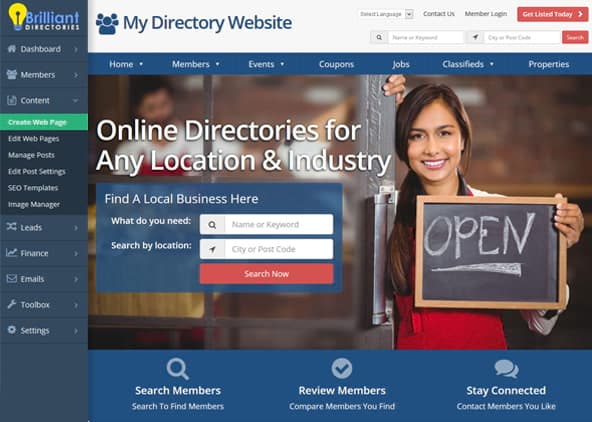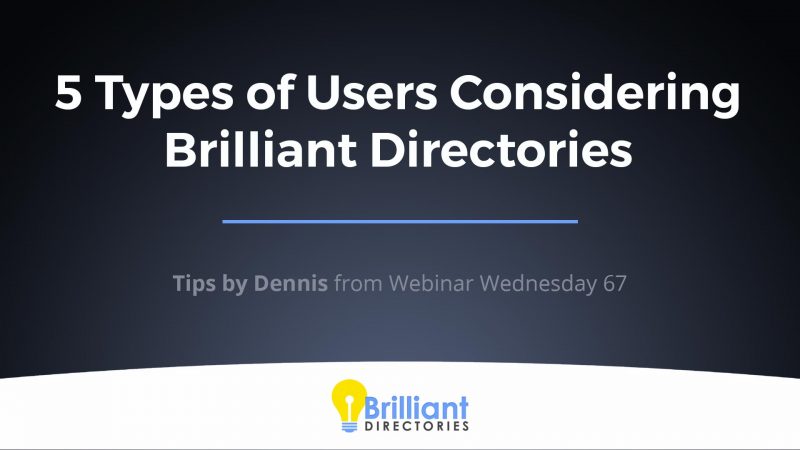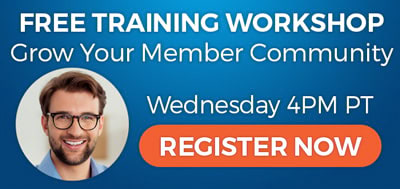
This Tip of the Week covers topics including:
- What Are Online Directories
- Why Directories Are Awesome
- How They Were Used In The Past
- The Rules Have Changed
- What’s Changed The Last Few Years
- How Successful Directories Evolved
- 5 Signs You’re On The Right Track…
This is a segment called The Evolution of Successful Directories from Webinar Wednesday 51, recorded live on October 31, 2018.
Online directories are not dead…
However, we need to understand the anatomy of a successful online directory because it is not just a website with bunches of links leading to other resources.
Once you understand what makes a good directory, you can find out how to grow it to create a resourceful community.
1) What Are Online Directories?
These are websites where people can post or find searchable resources. Good examples of online directories include websites such as Zillow, Yelp, LinkedIn, Capterra, Angi (formerly Angie’s List), Pinterest and Eventbrite to name but just a few.
If you fine-tune your online directory, it is quite possible to give people more organized searchable content, even better than Google.
Many online directories have many things in common. One of them is that they are membership directories, so they allow people to sign up and create accounts with them. People can feel that they truly belong.
Secondly, they allow users to generate content.
Thirdly, users can search for content using certain keywords.
2) Why Directories Are Awesome
Directories are awesome because they offer single focus pages. For instance, Pinterest allows users to post pictures while Angies List is for finding professionals. Zillow has some of the best-organized property lists whileRetailMeNot is for coupons.
3) How They Were Used In The Past
In the past 15 years or so, online directories were mainly used for link building, where the idea was to put the URL to your website in as many websites as possible to increase relevance. Back then, the listing was simple and it did not really provide enough information. The result was that one had many pages with thin content to click through before getting back to the page with value. So, we could say online directories were used to create internal links, which Google considered (still does) a ranking factor.
Another way that directories were used in the past is that people used to import millions of records of business data and Google would start ranking such pages.
This was a way to trick Google into sending tons of traffic. However, Google engineers wised up and adjusted their algorithm.
4) The Rules Have Changed
Google has changed the rules for ranking (sending traffic) to websites. For instance, it considers what value a website is giving its users. Thus, lately, Google’s algorithm updates have been more user-focused than publisher-focused.
Google has also changed the way that it sends traffic to new websites. A new website that seems to generate tons of web pages is considered as a spam website and it might never get any traffic sent to its pages.
Many SEO businesses have been “destroyed” by Google when people tried to trick Google into showing their search results first.
5) What’s Changed The Last Few Years
A lot has changed with how Google ranks websites and this means community websites. One thing that Google considers is how well you are serving people. Do people come to your community with queries? Do you have a following on social media or are you in the process of building one?
There are now more competitors than ever, with millions of websites going live every day. Another thing that has changed is that people are now smarter, more informed and they know what they want. If a community website is not serving their needs, they know and they leave soon after.
If a user clicks a link on your website, Google can “measure” the value the webpage ads to the user depending on how long they stay on the page, whether they browse to other pages on the website from there and so on. If users realize there is no value in the page, they leave immediately.
6) How Successful Directories Evolved
With the change in the rules, there was a need to do things differently. Here is how successful directories have evolved:
- The first thing is to identify your audience. You need to choose the MAIN audience that your directory website is intended to serve. If you have many audiences, it will take immense resources to meet all of their needs.
- The second thing is to identify the one need of that audience that you are going to serve fully and with authority.
- The third way to help your website evolve is to give people a clear mission and reason to join the website. Searching and finding something is not good enough. You need to give people a reason to want to be part of your community.
- The fourth and fifth ways to create a successful directory is to give members of the community helpful resources and then getting rid of anything else that does not serve the purpose of the website. Less clutter is better.
7) 5 Signs You’re On The Right Track
Once you have started building your community website, here are the signs you are on the right track:
- The homepage explains the problem so the users know what type of need it is you are trying to help them meet.
- The content never goes out of the needs scope of the intended audience and on the home page, you only post links that lead to the relevant resources.
- Only include the most relevant or important links in your website’s main menu. If you have too many links in your main menu then it becomes easier for users to overlook important menu items.
- You also need to share helpful information detailing how you have helped businesses and people. This is very good for engaging your audience. You can share social media links (with a gallery of you helping businesses) or create posts right there on the page.
- Finally, you need to have a nurturing or onboarding strategy, which is a way of following up and engaging people who join your website.
This can be by doing things such as helping them create their profiles, inviting them to follow you on social media and generally nurture a relationship before moving on to try and win another member.
The Takeaway – You must have the mindset that directory websites are products that need to be packaged and presented properly.

 AI-Generated Transcript – Please excuse any inaccuracies
AI-Generated Transcript – Please excuse any inaccuracies
The Evolution of Online Directories
- Directories are not dead, and understanding their evolution is crucial to the success of a directory website, as things have changed over the past few years and the last decade in terms of the value they bring to members and how they build a community (00:00:16).
- Online directories are essentially websites where people can find and post searchable resources, and many popular websites, such as Zillow, RetailMeNot, and Pinterest, are actually directories that allow users to post content and search for content (00:01:03).
- Successful directories provide a better service than Google by focusing on a specific type of content, such as property listings or coupons, and making themselves more valuable for that type of service (00:01:42).
- Having a single content focus is a key theme for successful Web directory, as seen in examples like RetailMeNot, Angi Inc., Zillow, Eventbrite, and Pinterest, which have all done a better job of presenting their specific type of content than Google (00:02:37).
- When building a directory, it’s essential to think about solving a problem and identifying an issue that isn’t being addressed, and providing a reason for users to come back to the site, as seen in the examples of successful directory websites (00:03:23).
- In the past, directories were used for link building, where websites would try to get their link on as many other websites as possible, but this is no longer the primary use of directories, and instead, they are now focused on providing valuable content and services to users (00:04:03).
- Directories were initially simple resources with limited information, such as a name and phone number, and required users to dig through multiple pages to find what they were looking for (00:04:17).
- The old directory sites had numerous hurdles, including multiple pages with low-value content, except for internal linking, which was overdone at the time (00:04:26).
- Google has improved its algorithms to detect and penalize websites with thin pages that have no valuable content, and now considers rapid growth or an excessive number of web pages as red flags (00:05:09).
- Some directory sites attempted to outsmart Google by aggregating or duplicating content, but this approach often resulted in penalties when Google updated its algorithms (00:05:21).
- There are instances where websites were severely affected by Google’s algorithm updates, such as an Search engine optimization company that built a business by exploiting a weakness in Google’s formula, only to have its progress wiped out by a subsequent update (00:06:31).
- Building a business by taking shortcuts or trying to stay one step ahead of Google is not a sustainable approach, as evidenced by the story of the SEO company that had to close down after its business model was no longer viable (00:07:19).
The Shift in Focus and Value
- Despite the limitations and challenges of old Web directory, they did have value in the past, and there were portals and resource websites that provided links and information, which was the standard approach at the time (00:07:53).
- The Google updates have led to changes in how websites are ranked, with a focus on serving people and adding value, rather than just optimizing for SEO, which can be achieved by following straightforward best practices and strategies, and employing checklists to ensure all good SEO practices are being implemented (00:08:08).
- To succeed, websites need to earn people’s trust by being an authority in their industry, having a professional-looking website, and showcasing social proof, such as testimonials, a large community, and an active social media following, which can help establish credibility and trust with potential members (00:08:56).
- The increased number of competitors and websites has made it harder to trick people, as they are now more savvy and can look through misleading information, making it essential for websites to have a unique voice, brand, and culture to stand out and attract members (00:09:27).
- Having a genuine and unique brand and culture behind a directory website can help it stand out from competitors and attract savvy potential members who can recognize the value and specialness of the site (00:10:09).
- The algorithms used by Google and other advertising platforms have changed to prioritize content that is worthy of people’s trust, and websites need to deliver high-quality content that meets users’ expectations to build trust and retain visitors (00:10:43).
- Google’s algorithms can identify if a website is delivering content that is worthy of people’s trust by tracking how long users stay on the website, whether they browse other pages, and if they interact with the content, which translates to trust and can impact the website’s ranking (00:10:53).
- It is essential for websites to cater to users’ expectations and deliver high-quality content to build trust and retain visitors, as users are quick to leave a website if they do not find valuable content, and this can negatively impact the website’s reputation and ranking (00:11:31).
Building a Successful Directory: Focus and Mission
- Successful directories have evolved over time by putting more care into their brand, even when doing things quickly, and presenting their website to the world in a well-crafted manner compared to their competitors (00:12:12).
- To create a successful directory, it is essential to identify one main audience that the website will cater to, as trying to serve multiple audiences can be a logistical nightmare and lead to poor organization of content (00:13:00).
- Once the audience is identified, it is crucial to find one need and fill it exceptionally well, rather than trying to offer a wide range of features that may not be necessary or useful to the target audience (00:13:51).
- Having a clear mission and reasons to join the website is vital, and these reasons should be specific and compelling, rather than just generic statements (00:14:53).
- When creating a membership or association website, it is essential to provide a reason why people want to join, just like when selling a physical product, and this reason should be unique and differentiate the website from others (00:15:56).
- Simplifying the website’s offering, purpose, and mission is also important, and this can be achieved by focusing on one key feature or service and presenting it in a clear and concise manner (00:12:53).
- Creating a successful directory website requires a clear mission and messaging to potential members, as simply providing a search function is not enough to attract users (00:16:09).
- A directory website should be able to differentiate itself from competitors, especially when breaking into a new sector, and having a local angle can provide a competitive edge (00:17:20).
- Identifying a clear audience and explaining the mission and reasons to join the website are crucial steps in creating a successful directory, and the website should provide resources that directly support its mission (00:19:06).
- The mission statement should be able to finish the sentence “because we’re doing X Y & Z” with a clear explanation of what the website is doing and for whom, and if this cannot be done, then the website does not have a clear message or audience (00:18:31).
- To effectively communicate the mission and messaging, it is essential to remove any unnecessary elements from the website that may be getting in the way, as the goal is to have a clear and concise message that resonates with the target audience (00:19:32).
- Creating a successful directory website involves being direct with people and making it easy for them to connect with the mission, which can lead to them wanting to join the cause, and this direct approach is crucial for building a community (00:19:56).
Engaging the Community and Building Trust
- The home page of the directory website is critical, as it should explain the problem being solved, and it is essential to speak directly to the main audience being catered to, making sure the content is tailored to that audience (00:20:29).
- A key example of a successful directory is Yelp, which caters to the person visiting the restaurant, despite making money from restaurant owners, and its content is directed towards that audience, with the business owners’ information being less prominent (00:20:53).
- Yelp’s focus on a few key things, such as finding restaurants and reading reviews, has contributed to its success, and it has grown from a simple concept to offer additional features like coupons (00:22:03).
- Engaging the community is vital, and this can be achieved by sharing updates, such as writing posts about local businesses, showcasing them on social media, or writing articles about them, to demonstrate that the mission is being supported and that the website is not stagnant (00:22:36).
- Sharing updates and showcasing activity behind the brand is essential, as people want to see that there is a pulse and that the website is not just a static collection of links, and a good example of this is the local directory website LocalShops1.com (00:23:16).
- Creating a successful directory website involves having an onboarding or nurture strategy to reach out to people after they’ve signed up, which can include welcome emails, social media engagement, and phone calls to help set up their profiles, and this is crucial for keeping the relationship alive and demonstrating expertise and credibility within the industry (00:23:50).
- The onboarding process should provide additional value and surprise new members, whether they’ve signed up for a free or paid membership, and this can be achieved by offering useful updates, newsletters, and other forms of communication to keep them engaged (00:24:39).
- Nurturing end users, such as reviewers on a site like Yelp, is also important, as they are a key demographic that can provide valuable feedback and participate in the community, and enrolling them in a nurturing campaign can encourage them to return to the site and get involved (00:25:19).
- Giving end users more reasons to come back to the site through nurture strategies and sequences is essential for building a loyal community, and this can be achieved by providing a sense of community and culture behind the website’s name (00:26:10).
- Packaging the directory website as a product with a personality and culture behind it can help people feel like they’re part of something, rather than just being listed in a directory, and this can lead to increased engagement and loyalty (00:26:30).
- Creating a sense of community behind the brand is key to making it easier for people to stick around and join the mission, whether passively or actively, and this can be achieved by showcasing the organization’s personality and culture (00:27:27).
- Creating a directory is not just about leaving it online for people to join, but also about giving them a reason and a purpose to follow, which can be achieved by having a voice and a personality to keep people engaged (00:27:38)
- The purpose of a directory is to provide a mission for people to follow, and this can be accomplished by actively maintaining the directory and providing value to its members (00:27:40)
- In order to make people stick around, it is essential to have a unique voice and personality that sets the directory apart and keeps members interested and invested in the community (00:27:51)
Continuous Evolution and Adaptation
- The key to a successful directory is to continuously evolve and adapt to the changing needs of its members, which is particularly important in today’s evolved world (00:27:57)














